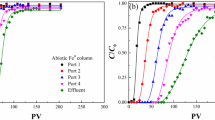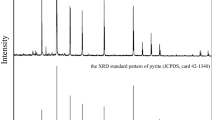Abstract
The reaction mechanisms Fe(II) abiotic oxidation produce ·OH by CaCO3-induced in acid mine drainage (AMD) are well-documented, but little is known about the influence of extracellular polymeric substances (EPS) secreted by microorganisms on Fe(II) oxidation in AMD. In this study, ·OH production was experimently measured from oxygenation of simulated AMD in the presence of EPS. The cumulative ·OH increased from 56.75 to 158.70 µM within 24 h at pH 3 with the increase in EPS concentration from 0 to 12 mg/L. An appropriate pH (about 6) and EPS (6 mg/L) concentration were required for the moderate rate of Fe(II) oxidation. Besides, the yield of ·OH increased remarkably with the addition of Fe3+. In the presence of EPS, ·OH production is attributed mainly the complexation of Fe(II) with EPS, of which is rich of carboxyl and hydroxyl groups. The findings provide fundamental supplement of ·OH production from Fe(II) oxidation by microorganisms in natural AMD.





Similar content being viewed by others
References
Abzac PD, Bordas FO, Hullebusch EV, Lens PNL, Guibaud G (2010) Effects of extraction procedures on metal binding properties of extracellular polymeric substances (EPS) from anaerobic granular sludges. Colloids Surf B 80(2):161–168
Ai Z, Gao Z, Zhang L, He W, Yin JJ (2013) Core-shell structure sependent reactivity of Fe@Fe2O3 nanowires on aerobic degradation of 4–chlorophenol. Environ Sci Technol 47(10):5344–5352
Boon M (2001) The mechanism of ‘direct’ and ‘indirect’ bacterial oxidation of sulphide minerals. Hydrometallurgy 62(1):67–70
Chen N, Fu Q, Wu T, Cui P, Fang G, Liu C, Chen C, Liu G, Wang W, Wang D, Wang P, Zhou D (2021) Active iron phases regulate the abiotic transformation of organic carbon during redox fluctuation cycles of paddy soil. Environ Sci Technol 55(20):14281–14293
Christina R, Keenan, David L, Sedlak (2008) Factors affecting the yield of oxidants from the reaction of nanoparticulate zero-valent iron and oxygen. Environ Sci Technol 42(4):1262–1267
Cohn CA, Mueller S, Wimmer E, Leifer N, Schoonen MAA (2006) Pyrite-induced hydroxyl radical formation and its effect on nucleic acids. Geochem T 7(1):3
Diaz JM, Hansel CM, Voelker BM, Mendes CM, Andeer PF, Zhang T (2013) Widespread production of extracellular superoxide by heterotrophic bacteria. Science 340(6137):1223–1226
Gomes JAG, Daida P, Kesmez M, Weir M, Cocke DL (2007) Arsenic removal by electrocoagulation using combined Al-Fe electrode system and characterization of products. J Hazard Mater 139(2):220–231
Guo H, Ren Y, Liu Q, Zhao K, Li Y (2013) Enhancement of arsenic adsorption during mineral transformation from siderite to goethite: mechanism and application. Environ Sci Technol 47(2):1009–1016
Kinzler K, Gehrk T, Telegdi J, Sand W (2003) Bioleaching-a result of interfacial processes caused by extracellular polymeric substances (EPS). Hydrometallurgy 71:83–88
Kang F, Alvarez PJ, Zhu D (2014) Microbial extracellular polymeric substances reduce Ag+ to silver nanoparticles and antagonize bactericidal activity. Environ Sci Technol 48(1):316–322
Kang F, Qu X, Alvarez PJJ, Zhu D (2017) Extracellular saccharide-mediated reduction of Au3+ to gold nanoparticles: new insights for heavy metals biomineralization on microbial surfaces. Environ Sci Technol 51(5):2776
Keenan CR, Sedlak DL (2008) Ligand-enhanced reactive oxidant generation by nanoparticulate zero-valent iron and oxygen. Environ Sci Technol 42(18):6936–6941
King DW, Lounsbury HA, Millero FJ (1995) Rates and mechanism of Fe(II) oxidation at nanomolar total iron concentrations. Environ Sci Technol 29(3):818–824
Learman DR, Voelker BM, Vazquez-Rodriguez AI, Hansel CM (2011) Formation of manganese oxides by bacterially generated superoxide. Nat Geosci 4(2):95–98
Li WW, Yu HQ (2014) Insight into the roles of microbial extracellular polymer substances in metal biosorption. Bioresour Technol 160:15–23
Long D, Hashmi MZ, Su X, Pongpiachan S (2019) Cr(VI) reduction by an extracellular polymeric substance (EPS) produced from a strain of Pseudochrobactrum saccharolyticum. Biotech 9(3):2–9
Miller CJ, Rose AL, Waite TD (2013) Hydroxyl radical production by H2O2-mediated oxidation of Fe(II) complexed by Suwannee River fulvic acid under circumneutral freshwater conditions. Environ Sci Technol 47(2):829–835
Page SE, Kling GW, Sander M, Harrold KH, Logan JR, Mcneill K, Cory RM (2013) Dark formation of hydroxyl radical in arctic soil and surface waters. Environ Sci Technol 47(22):12860–12867
Pagnanelli F, Mainelli S, Bornoroni L, Dionisi D, Toro L (2009) Mechanisms of heavy-metal removal by activated sludge. Chemosphere 75(8):1028–1034
Park B, Dempsey BA (2005) Heterogeneous oxidation of Fe(II) on ferric oxide at neutral pH and a low partial pressure of O2. Environ Sci Technol 39(17):6494–6500
Pullin MJ, Cabaniss SE (2003) The effects of pH, ionic strength, and iron-fulvic acid interactions on the kinetics of non-photochemical iron. The kinetics of thermal reduction. Geochim Cosmochim Acta 67(21):4079–4089
Remucal CK, Sedlak DL (2011) The role of iron coordination in the production of reactive oxidants from ferrous iron oxidation by oxygen and hydrogen peroxide. ACS Symp. Ser. 1071, 177–197
Rodrguez Y, Ballester A, Blázquez ML, González F, Muoz JA (2003) New information on the pyrite bioleaching mechanism at low and high temperature. Hydrometallurgy 71(1):47–56
Stumm W, Lee GF (1961) Oxygenation of ferrous iron. Ind Eng Chem Res 53(2):143–146
Wang J, Bai J, Xu J, Liang B (2009) Bioleaching of metals from printed wire boards by acidithiobacillus ferrooxidans and acidithiobacillus thiooxidans and their mixture. J Hazard Mater 172(2):1100–1105
Webb JA, Sasowsky ID (1994) The interaction of acid mine drainage with a carbonate terrane: evidence from the Obey River, north-central Tennessee. J Hydrol 161(1–4):327–346
Wei X, Fang L, Cai P et al (2011) Influence of extracellular polymeric substances (EPS) on Cd adsorption by bacteria. Environ Pollut 159(5):1369–1374
Xie W, Yuan S, Tong M, Ma S, Liao W, Zhang N, Chen C (2020) Contaminant degradation by ·OH during sediment oxygenation: dependence on Fe(II) species. Environ Sci Technol 54(5):2975–2984
Xu H, Cai H, Yu G, Jiang H (2013) Insights into extracellular polymeric substances of cyanobacterium Microcystis aeruginosa using fractionation procedure and parallel factor analysis. Water Res 47:2005–2014
Yamashita Y, Jaffe R (2008) Characterizing the interactions between trace metals and dissolved organic matter using excitation-emission matrix and parallel factor analysis. Environ Sci Technol 42(19):7374–7379
Yuan S, Liu X, Liao W, Zhang P, Wang X, Tong M (2018) Mechanisms of electron transfer from structrual Fe(II) in reduced nontronite to oxygen for production of hydroxyl radicals. Geochim Cosmochim Acta 223:422–436
Zhang P, Yuan S (2017) Production of hydroxyl radicals from abiotic oxidation of pyrite by oxygen under circumneutral conditions in the presence of low-molecular-weight organic acids. Geochim Cosmochim Acta 218:153–166
Zhang P, Yuan S, Liao P (2016a) Mechanisms of hydroxyl radical production from abiotic oxidation of pyrite under acidic conditions. Geochim Cosmochim Acta 172:444–457
Zhang T, Hansel CM, Voelker BM, Lamborg CH (2016b) Extensive dark biological production of reactive oxygen species in brackish and freshwater ponds. Environ Sci Technol 50(6):2983–2993
Zhu J, Zhang P, Yuan S, Liao P, Qian A, Liu X, Tong M, Li L (2017) Production of hydroxyl radicals from oxygenation of simulated AMD due to CaCO3-induced pH increase. Water Res 111:118–126
Zhu J, Zhang P, Yuan S, Tong M (2020) Arsenic oxidation and immobilization in acid mine drainage in karst areas. Sci Total Environ 727:138629
Acknowledgements
This work was supported by the science and Technology Foundation of Guizhou Province (NO.(2018)1155), the Natural Science Foundation of China (NO.41763018), and the Program Foundation of Institute for Scientific Research of Karst Area of NSFC-GZGOV (NO.U1612442).
Author information
Authors and Affiliations
Corresponding author
Additional information
Publisher’s Note
Springer Nature remains neutral with regard to jurisdictional claims in published maps and institutional affiliations.
Rights and permissions
About this article
Cite this article
Zhong, X., Liu, F., Wu, P. et al. Production of Hydroxyl Radicals from Oxygenation of Simulated Acid Mine Drainage in Presence of Extracellular Polymers Substances. Bull Environ Contam Toxicol 109, 771–775 (2022). https://doi.org/10.1007/s00128-022-03489-4
Received:
Accepted:
Published:
Issue Date:
DOI: https://doi.org/10.1007/s00128-022-03489-4




